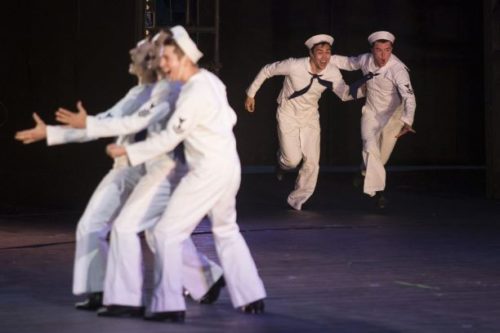Debra Dickinson Presents “Jerome Robbins on Broadway” at ERJCC
 Even if one is not a fan of Broadway musicals, the name and legacy of Jerome Robbins is clearly understood, especially as a dancer. I can’t say this with definitive certainty, but I’m sure that everyone with an inclination to move has had, at least at one point in their lives, a fantasy of themselves dancing a scene from West Side Story. The choreography of “The Dance at the Gym,” “America,” and “Cool,” is so bold, so infectious, so believably human, it’s difficult to simply watch. These scenes stir the soul to get up and dance.
Even if one is not a fan of Broadway musicals, the name and legacy of Jerome Robbins is clearly understood, especially as a dancer. I can’t say this with definitive certainty, but I’m sure that everyone with an inclination to move has had, at least at one point in their lives, a fantasy of themselves dancing a scene from West Side Story. The choreography of “The Dance at the Gym,” “America,” and “Cool,” is so bold, so infectious, so believably human, it’s difficult to simply watch. These scenes stir the soul to get up and dance.
On April 17, Debra Dickinson of Rice University will give the lecture Jerome Robbins on Broadway at the Evelyn Rubenstein Jewish Community Center’s Kaplan Theatre. Dickinson will discuss Robbins’ major works, his whirlwind career trajectory, and his contribution to the American musical theater art form, which extends beyond his abilities as a choreographer.
Perhaps what makes Robbins’ work so compelling is its relatability. In his musicals, the characters don’t arbitrarily stop to do a fancy jig. Their dancing is motivated by the storytelling, and their steps are true to character. “You believed that the characters in his show really would dance in the style he choreographed for them,” says Dickinson “from the sailors in Fancy Free, to the teenagers in West Side Story, to the men at the wedding doing the bottle dance in Fiddler on the Roof, to the Siamese dancers putting on their version of the Small House of Uncle Thomas in The King and I, to the strippers in Gypsy.”
Dickinson identifies Robbins’ training as a Method actor as his choreographic impetus. His style shifted to the demands of the story, molding it to the time, place, and culture of the scene onstage. As a result, his dancers also had to be fine actors. West Side Story, for example, was one of the first instances where the major players had to be triple threats – the leads not only act and sing, but carry some of the most weighty dance sequences.
Dickinson’s lecture will also reveal insights into Robbins’ working style, including the dark side of his rehearsal process. A perfectionist of the highest degree, he was known to verbally abuse his cast and crew. Even though roles in his musicals, including those in the chorus, were highly coveted, he was feared by many. To illustrate this duality, Dickinson shares this well-known anecdote: “The most famous story is that he was backing up while berating his actors during a rehearsal, stepping closer and closer to the orchestra pit…they watched in complete silence as he fell in the pit! Not a soul warned him.”
Robbins was, indeed, an exceptional choreographer, but his eye for detail, keen understanding of character and plot, and innate ability to see the big picture made him an equally heavyweight director. Prior to Robbins, the producer was the eminent figure of the Broadway stage, but with his biggest hits came the understanding that now the director was also a star. As Dickinson explains, “He was instrumental in the writing process of his biggest shows, from their very conception – West Side Story, Gypsy and Fiddler on the Roof – making the role of director much more important than it had been in the past.” Choreographer/directors Bob Fosse and Michael Bennett worked with him in their early careers, and would go on to create some of the most seminal Broadway titles of their time, including Pippin, Chicago, A Chorus Line, and Dreamgirls, respectively. Hal Prince and Stephen Sondheim also spent time working under Robbins.
What makes Robbins’ work so compelling is that his musicals transcend simple entertainment. “He developed the concept musical,” says Dickinson, “which goes far beyond the book musicals of Rodgers and Hammerstein, in that there is a message or theme that ties the show together more than the plot.” Robbins’ attention to detail, and his elevation of dance within the musical structure, changed the way audiences experienced the Great White Way. In his worlds, dance isn’t a background confection, but the core of what makes us, well, human.
The lecture, which will include video clips, will be presented by Debra Dickinson on Wednesday, April 17 at 7pm at the Evelyn Rubenstein Jewish Community Center. Tickets and more information can be found at erjcchouston.org.



Recent Comments